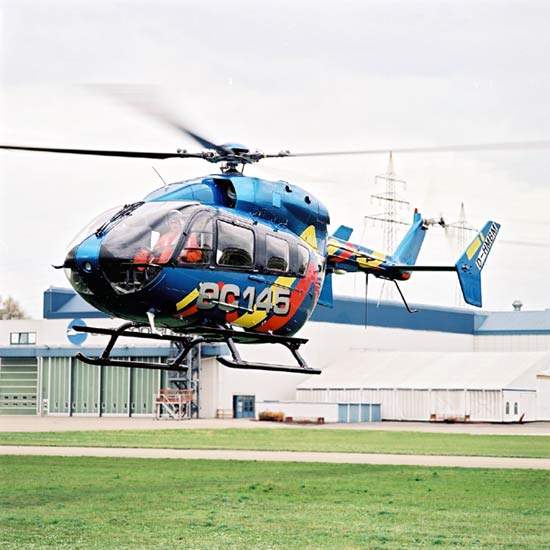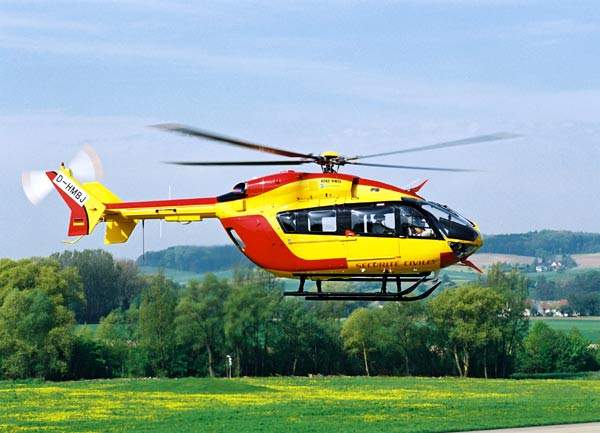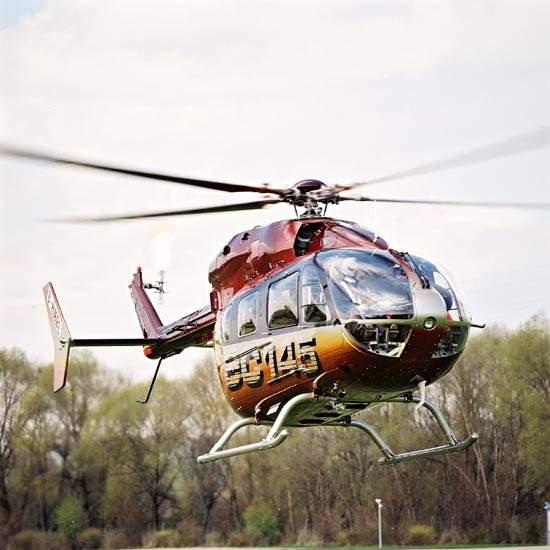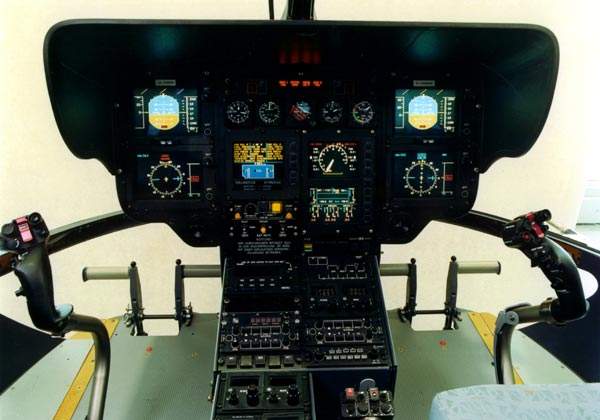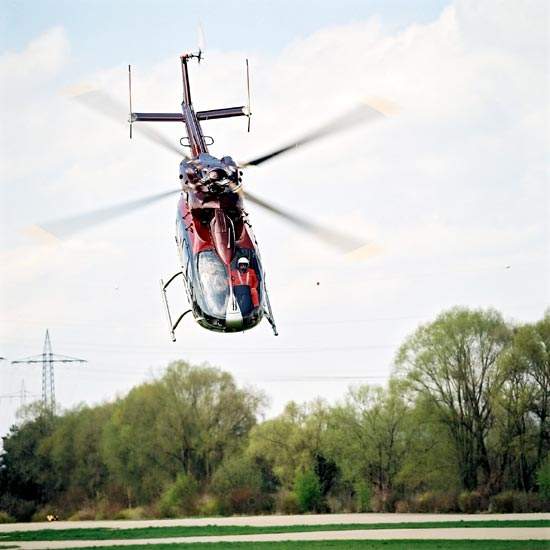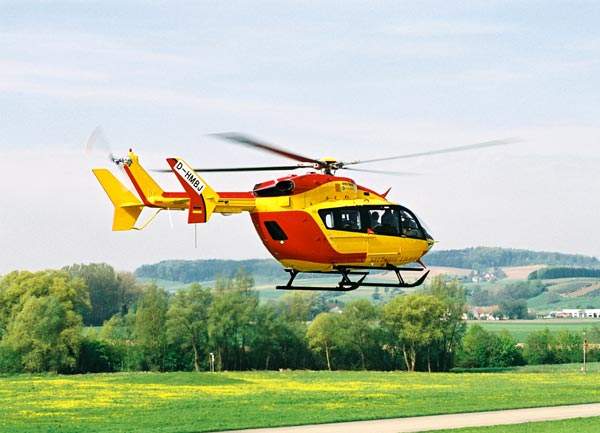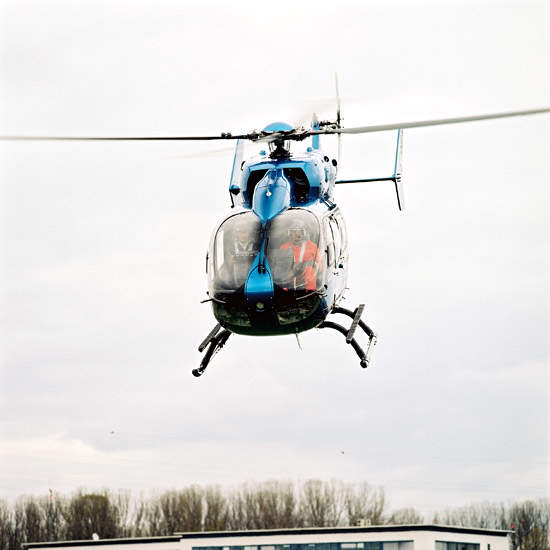The EC 145 multi-role helicopter has been jointly developed by Eurocopter and Kawasaki Heavy Industries of Japan. The EC 145 is a development of the Eurocopter / Kawasaki BK 117 C-1 with increased take-off weight and cabin volume. The helicopter is designated the BK 117 C-2 in Japan. The EC 145 completed its first flight in 1999.
The first two customers for the EC 145 were the French Sécurité Civile, the French civil defence and emergency preparedness organisation, which placed an order for 32 EC 145s in December 1997, and the French Gendarmerie which placed an order for eight helicopters in 1999.
The first EC 145 was delivered to the Sécurité Civile in April 2002 and deliveries were completed in May 2005.
Deliveries to the Gendarmerie began in December 2002 and concluded in 2006. Gendarmerie helicopters are being chiefly used for mountain rescue. A further seven helicopters were ordered for the Gendarmerie in August 2006, for delivery in 2007/2008. The Sécurité Civile ordered an additional five helicopters in December 2007.
Orders have been received for a total of 95 aircraft, of which 75 have been delivered.
Five helicopters are in service with the REGA air rescue organisation of Switzerland. Other operators include ADAC Air Rescue, Deutsche Rettungsflugwacht (DRF) and the Hesse state police of Germany. In April 2004, the first EC 145 was delivered to a customer in North America, Lee County Emergency Medical Services in Florida.
Recent orders include one for the Lithuanian Border Guard, ordered in December 2005 and delivered in January 2007, and three for the London Metropolitan Police Authority, ordered in February 2006 and delivered in July 2007.
In June 2006, the EC145, designated UH-145, won the US Army’s Light Utility Helicopter (LUH) competition. EADS North America was awarded a contract for the first eight of 322 helicopters. A further 34 were ordered in November 2006. The first helicopter, re-designated UH-72A Lakota, was delivered in December 2006.
The helicopter can be kitted out for a number of missions including search and rescue, police and federal roles, surveillance, firefighting, mobile command centre, cargo, passenger and VIP transport, search and rescue, medical evacuation, training and
offshore support.
The helicopter has a mission endurance of three hours 25 minutes with 30 minutes reserves. The fast cruise speed is 245km/h.
DESIGN
The helicopter was developed as a modified version of the BK 117 multi-role helicopter but with a substantially increased cabin volume, a 150kg increase in take-off weight and a 25% increase in range. The increases in maximum take-off weight and range
are mainly achieved through the installation of new blade airfoils.
The forward fuselage and nose section are based on the design of Eurocopter’s EC 135 helicopter and give the pilot improved visibility. The rotor blades have the same profile as used on the EC 135 helicopter. The blades provide a significantly reduced
vibration profile inside and outside the helicopter.
COCKPIT
The helicopter is fitted with an all-glass Thales Avionics Meghas avionics suite with four-axis dual digital autopilot and is configured for dual- or single-pilot Instrument Flight Rules (IFR) operation. Meghas is part of Thales ‘Avionique Nouvelle’ suite
which is used in modular form on Eurocopter EC 120 and EC 155 helicopters.
Meghas has two main display systems. The Central Panel Display System (CPDS) comprises a Vehicle and Engine Management Display (VEMD) with two active matrix liquid crystal displays and a Caution and Advisory Display (CAD) for alarm and fuel management with one active matrix liquid crystal display.
The flight control display system comprises four SMD45H 4in x 5in LCD smart multifunction displays for navigation and flight control. It is controlled by a Pelican modular rack with modules
tailored to the application. Thales Avionics also provides the primary air data references (ADU 3000 air data unit and temperature probe), as well as the control panels.
SFIM Industries (now SAGEM) developed the automatic flight control system which includes an Attitude and Heading Reference System (AHRS).
The EC 145 can be fitted with EADS HELLAS obstacle warning system. HELLAS is based on an eyesafe laser radar.
EC 145 helicopters in service with the government of Georgia for VIP transport are being fitted with the EADS Defence Electronics Airborne Missile Protection System (AMPS), which includes MILDS missile warner and a countermeasures dispenser.
Mission systems for the police air support role can include: Wescam MX-15 electro-optic surveillance system, SkyQuest touch-screen video management system and the Gigawave digital video link, enabling the helicopter to be used as an incident command and control platform.
The cockpit is night vision goggle compatible and, in June 2007, the EC145 became the first commercial helicopter to be certified for civil night vision goggle operations, using either ITT F949 or Nogalight NL-93 NVGs.
CABIN
The cabin can be configured for eight passengers in a standard 3+2+3 arrangement or up to 11 passengers for high-density operations. The EC145 is fitted with Martin-Baker Aircraft’s passenger seats.
The cabin, cockpit and cargo compartment have a level floor throughout to give a spacious and easily reconfigurable cabin. The cabin is nearly 46cm longer and 13cm wider than the BK 117 helicopter.
The centre posts and door posts of the BK 117 C-1
have been removed and outsize lateral doors on both sides of the aircraft and wide opening rear clam shell doors give easier access. Wide windows give crew and passengers clear visibility.
A rescue hoist with variable winch speed and 90m of cable, rated at 270kg load, can be installed. An external cargo hook is rated at 1,500kg.
In the medical evacuation role the helicopter can carry two stretcher patients, a team of six medical attendants and medical equipment.
ENGINES
The tailboom is attached to the engine deck and the engine deck is above the cargo compartment roof. The helicopter has two Turbomeca Arriel 1E2 turboshaft engines each rated at 516kW maximum continuous power.
Four flexible bladder tanks are installed in the fuel compartments under the cabin floor. The fuel capacity is 757l which gives the helicopter a range of 670km at maximum take-off weight.


